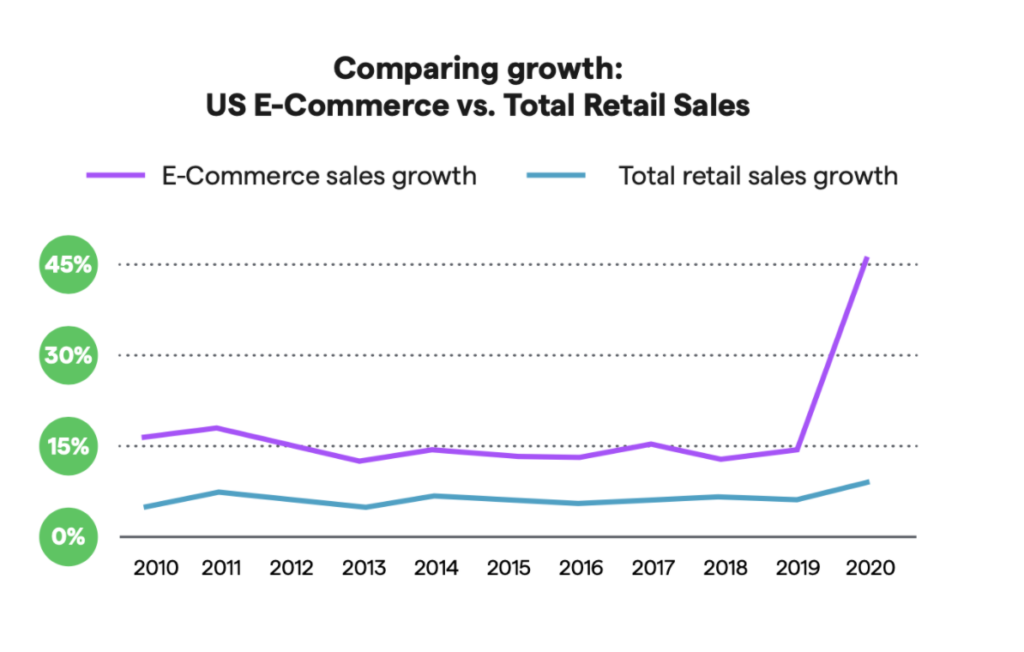Will brick-and-mortar retail bounce back in 2022?
by September 16, 2021
During the pandemic, it’s no surprise that in-person shopping took a hit. Now that we are entering the final quarter of 2021, we’re starting to look ahead to what brick-and-mortar retail might look like going forward. After a tumultuous 2020 and 2021, are consumers ready to get back out into the world and shop in-person again? Will e-commerce continue to be the driving outlet for retail or will in-person shopping make a comeback? Let’s see what the data says.
The Covid E-Commerce Bump
TaxJar recently partnered with research firm Alter Agents to gain insights into how financial professionals are assessing the future of e-commerce. We interviewed over 500 financial professionals across industries — and 74% of those interviewed have done more business in e-commerce since the start of the pandemic.
The growth in e-commerce sales after the Covid pandemic has been, what’s the word we’re looking for, unprecedented.The data shows US sales grew by 44 percent in 2020 as the pandemic shifted a lot of buying online. A majority of this shift came from consumers who would have likely preferred to purchase in store but turned to online channels due to health and safety concerns.
But will this move to e-commerce stick in 2022? According to our survey, 78% of financial professionals believe their e-commerce business will only grow in the future. But how are consumers feeling?
Survey says..
The Morning Brew recently did a survey with Harris Poll asking adults in the US how they were thinking about returning to in-person shopping. The results might surprise you.
According to the survey:
- 63% of respondents will do most of the shopping in person this holiday season compared with 37% who said online. When a similar survey was done in March 2021, the split was 43% in person and 24% for online.
It seems that as we make more progress to get through the pandemic through vaccines, consumers feel more confident to get back out into brick and mortar retail. It’s also possible this represents a longing on the part of the consumers to get back into physical retail spaces after shifting so much of their shopping online over the past year and half. After being cooped up for a year, consumers might be missing the in-person shopping experience.
It’s also important to note that not all consumers have abandoned in-person shopping entirely. In fact, the majority of Americans (71%) shop in person at least once a week currently. As you can see from the chart below, total retail growth, which encompasses in-person and e-commerce, saw a slight increase in 2020. However, there was a huge increase in the portion of U.S. e-commerce sales.

So how can retailers serve both types of customers? And how do they ensure they are collecting the correct amount of sales tax for both scenarios?
E-Commerce and Brick and Mortar Working Together
Supporting both types of buying scenarios begins with ensuring your online and in-store customer experiences are solid. Goes without saying, having a strong e-commerce store is key. Don’t make it difficult for shoppers to find what they are looking for on your site. Make it simple for them to shop, search, and checkout. You want the shopping and checkout experience to be as positive for your customers as possible.
Find ways to mimic the traditional brick and mortar experience that shoppers are accustomed to. For example, for a clothing retailer, consumers are used to trying things on before buying. To try and give them a similar experience in the new model, give customers the option to buy items online and send them back with free returns if they don’t fit properly or don’t want to keep the item.
Alternatively, bringing customers back to brick and mortar stores is about safety and comfortability. Being transparent and vocal when it comes to your safety measures can help customers be more comfortable coming back in-person. Will you have hand sanitizer available? Are you going to require masks? These types of questions are for each business owner to decide, but communicating these to your customers is key.
You might also consider bridging the gap between e-commerce and physical retail. Have you implemented a buy online, pick up in store policy? As customers start trickling back into physical retail, this gives them an option to continue to make purchases online, while also still coming to the store.
The sales tax puzzle piece
Preparing for a positive online shopping customer experience means you need to consider how you are calculating and collecting sales tax as well. When you jump into e-commerce, you’re opening your business up to sales that might be outside of your state. You’re going to need to consider how you are managing your sales tax calculations. From which customers to charge, to what amount to charge, to how to go about filling out a sales tax, sales tax is different when selling online.
E-commerce sales tax management gets more complicated because the point of sale changes when buyers purchase online. Making sales across the country means you are now responsible for collecting varying different amounts of sales tax. If you don’t want to keep up with what sales tax rate to charge when and where, TaxJar can help automate the process.
The good news is that sales tax management is simpler for your physical locations. Since your physical location is the point of sale, you don’t worry about varying sales tax rates and only charge the rate for your location.
The future of retail
We aren’t certain what the future holds—our crystal ball has been on backorder for a year now. But if the surveys and data points tell us anything, it’s that consumers are ready for in-person shopping again. However, they won’t be totally shifting away from e-commerce either – so businesses need to prepare to support both experiences.
If you are thinking that preparing your business to serve both customers is a daunting task, we’d invite you to also consider how this opens the door to opportunities and customers you have not been able to meet in the past. With a combination of in-person retail and e-commerce sales, the possibilities are endless.
Start a free trial with TaxJar today and see how we can help you stay in compliance as your business grows and takes on new opportunities.








